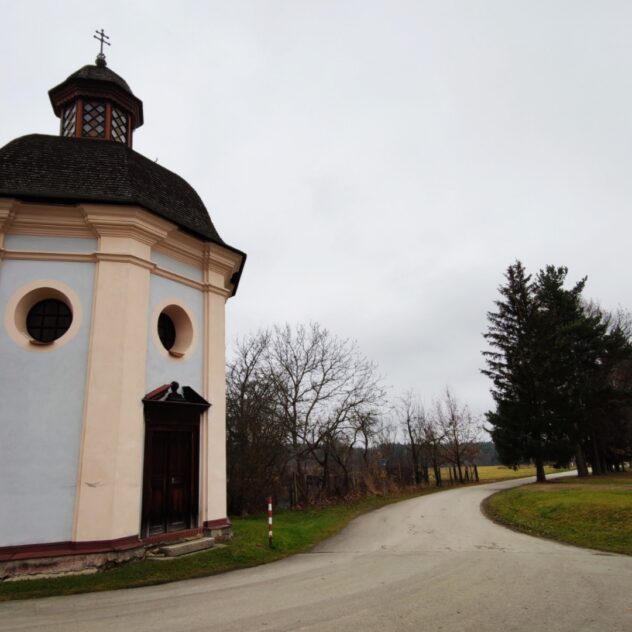Římov
Information about the pilgrimage site
The local landscape has been inhabited by Slavic people since the 8th century. The village of Římov was probably founded in the 13th century and belonged to small noble families until the mid-16th century. From 1541 it was in the possession of the Ojířs of Protivec, under whom a brewery was established in Rimov. In 1622, Ctibor Ojíř of Protivec was confiscated for his participation in the Bohemian Estates Uprising, which included the estate in Rimov.
Four years later, Římov passed into the hands of Oldřich of Eggenberg, the owner of the Český Krumlov estate. In the same year, he donated the Rimov estate to the Jesuit College in Český Krumlov to support the boys’ seminary. At the suggestion of the Jesuit apothecary Jan Gurre of Český Krumlov, a pilgrimage site with a Loreto chapel and an extensive Stations of the Cross was founded in Římov in 1648. Around the Loreto chapel, a four-sided ambit was built and a little later also the Church of the Holy Spirit.
Since 1694, two Jesuit missionaries permanently resided here and took care of the spiritual care of the pilgrims. Already during the second half of the 17th century, regular pilgrimage dates were established, namely on the feasts of the Finding of the Holy Cross, the Exaltation of the Holy Cross and the Visitation of the Virgin Mary and on the Feast of Pentecost. According to contemporary reports, 40,000 to 80,000 pilgrims came here annually.
At the time of the reforms of Emperor Joseph II, participation in pilgrimages declined for a time, but before the end of the 18th century there was a resurgence.
After the abolition of the Jesuit Order in 1773, the Romanov farm became the property of the religious fund, from 1801 it was in the possession of Prince Joseph of Schwarzenberg and later of several private owners. Until the 20th century it remained not only one of the most important pilgrimage sites in South Bohemia, but also a popular resort and a place of residence for many artists.
In the loreto there is a venerated statue of Our Lady of Rome with the Baby Jesus from 1689. The surrounding amphitheatres are decorated with paintings and rich sculptural decoration. The unique Stations of the Cross, called the Roman Passion, consisting of chapels of various sizes, has 14 stops and is 6 km long. It was designed by P. Alex, who returned from Jerusalem. There he measured the exact position of the various stops on the last journey of Jesus Christ and kept this distance in Rome. The Stations of the Cross honour the landscape in which they are set, and the individual chapels are not the same. Some are painted, others have life-size wooden statues, and still others have interesting wooden backdrops. The centuries of development of the pilgrimage site have created a unique ensemble symbolized by the Virgin Mary, Jesus Christ and the Holy Spirit.
Tourist attractions in the vicinity
Zlatá Koruna Monastery – the Cistercian monastery Zlatá Koruna was founded by King Přemysl Otakar II in 1269. Its original name, the Holy (Thorny) Crown, was given to it after a precious relic, a thorn from Christ’s crown. The monastery was severely damaged during the Hussite wars and after several attempts at restoration was abolished by Emperor Joseph II. It was repaired and declared a National Cultural Monument. In 2016, a Gothic panel painting of Our Lady of Golden Crown was returned to the monastery. More at https://klaster-zlatakoruna.cz/cs .
Český Krumlov – the historic centre of Český Krumlov is situated on the banks of the meandering Vltava River. On one side, the Rožmberk Castle with its typical Renaissance tower towers above it and on the other side, the Church of St. Vitus, where William of Rožmberk is buried, towers above it. The historic centre of the town was inscribed on the UNESCO World Heritage List in 1992. After Prague, it is the most visited place in the Czech Republic. The distance from the pilgrimage site is 16 km. For more information visit https://www.ckrumlov.cz/cz/mesto-cesky-krumlov/ .
České Budějovice – the South Bohemian metropolis was founded by King Přemysl Otakar II in 1265. The most important monuments of the city include the Bishop’s Cathedral of St. Nicholas, the Gothic complex of the Dominican monastery with the Basilica of the Presentation of the Virgin Mary or Samson’s Fountain on the hectare square of Přemysl Otakar II. The first railway on the European continent from Budejovice to Linz was put into operation here, when the wagons were still pulled by horses. The beginning of the construction of the railway dates back to 1825. The distance from Rimov is 16 km. More at https://www.c-budejovice.cz/ .
Holašovice – a typical South Bohemian village has a very well-preserved village square in the style of peasant baroque, a building style popular in South Bohemian villages during the 19th century. For this reason it is a UNESCO World Heritage Site. The distance from Římov is 29 km. For more information visit https://www.holasovice.eu/co-videt .
Hluboká Castle – was originally built as a gothic guard castle. During the centuries it changed owners and was rebuilt several times. Since the 17th century it has been owned by the princely Schwarzenberg family. Its current appearance was created during an extensive reconstruction in 1840 – 1871, when the princely couple were inspired by the castle in Windsor during their visit to England. The distance from Rome is 29 km. More at https://www.zamek-hluboka.cz/cs .
Other tourist attractions in the area can be found on the website:
Accommodation
- Affordable accommodation is provided by TJ Sokol in Římov https://www.firmy.cz/detail/211698-ubytovani-tj-sokol-rimov-rimov.html
- Alternatively, commercial accommodation is possible in the surrounding villages.
Availability
By car
The pilgrimage site of Římov is easily accessible and there is a parking lot in front of the site.
By public transport
There is a bus to Římov and it is also possible to take a train from České Budějovice to Holkov station, from where it is a 3 km walk. More information can be found at www.idos.cz.
On foot
The site is located at the crossroads of marked hiking trails, details can be found at www.mapy.cz.
On a bicycle
There are several cycling routes through the pilgrimage site, more information can be found at www.mapy.cz.








